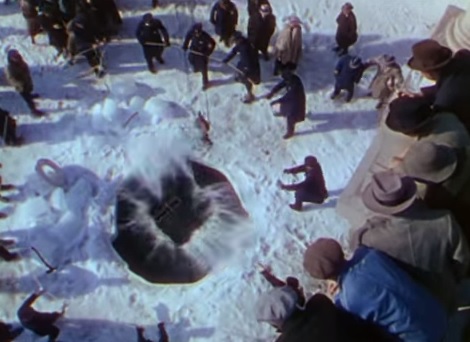
Houdini going in to the Detroit River (from the 1953 Paramount movie)
Seventy years ago today, November 17, 1944, the Milwaukee Journal carried an interesting item about the escape artist Harry Houdini. The previous Sunday, November 12, the radio program John Nesbitt’s The Passing Parade had carried a description of Houdini’s famous escape from under the ice covered waters of the Detroit River. This stunt was immortalized in the 1953 Paramount Movie Houdini starring Tony Curtis as Houdini. A still from the movie of the great escape artist’s crate being dropped into the icy water is shown here.
The Journal’s radio editor recounts the broadcast describing the “famous occasion 35 or more years ago when Houdini jumped into the Detroit river through a hole cut in otherwise solid ice that covered the river.” According to the paper, Houdini “stayed under water for six–or was it eight?–minutes, well beyond the time limit of known human endurance.” According to the paper, the mayor of Detroit and a “good crowd of sober citizens” witnessed the stunt and had the scare of their lives.
According to Nesbitt, Houdini “knew something.” He knew that the river had fallen an inch or so, and that there was an air-filled void between the surface of the water and the ice. As famously depicted in the movie, Houdini merely went to the surface, breathing the air until he located the hole.
But the mystery was apparently solved by a mysterious letter that showed up at Milwaukee station WTMJ after the broadcast. The anonymous author of the letter was from Grand Rapids, Michigan, (It’s quite plausible that the Milwaukee station had listeners in Grand Rapids, since the two locations are separated mostly by the waters of Lake Michigan, over which the groundwave signal of the 620 kilocycle station would easily pass.) The mysterious author of the letter offered up what seemed to be a very plausible explanation for the stunt.
The radio editor Richard K. Bellamy, opines that “to us it sounds as though the writer of the letter knew what he was talking about.” It also sounded to me like the writer knew what he was talking about, since he included a number of corroborating details.
The anonymous letter writer stated that he was an “expert diver” and “one of Harry’s accomplices on that day” and that he was paid $350 for his part. According to the writer, a sheet metal worker in Brooklyn fabricated a can which was filled with compressed air. The letter writer’s job was to place that can in the river, which he says he did the Sunday prior to the stunt. “Harry and I carefully measured the distance” from the hole in the river to the can, says the writer. The can was attached to “a sort of head mask and some rubber hose.” “He could have stayed under 30 minutes,” opined the writer.
The mysterious letter writer does offer some corroborating details. He notes that there “probably is, or was, a tinsmith in Brooklyn who could corroborate part of my story.” He noted the exact location, noting that “if you will check today, you will find a quantity of concrete piling along the banks of the river,” and that the can and its anchor “is probably still at the spot” under the water. He concludes by noting that “a little research will probably bear me out.”
The letter writer says that he can’t divulge his identity “for ethical reasons.” But he believed that it “is hardly fair to the radio public to let the hoax explanation be unchallenged.”
That certainly seems like a plausible explanation. After all, anyone could have gone to take a look at those concrete pilings. And retrieving, or at least locating, a large cylinder and concrete anchor down at the bottom of the river doesn’t seem like a major undertaking. And the anonymous explanation certainly seems more plausible than breathing, for an extended period of time, the tiny bit of air trapped under the ice. So the radio columnist was apparently convinced. And I was almost convinced, but for one small discrepancy.
That discrepancy was that the supposed ice escape, with or without assistance, never took place. The mayor of Detroit didn’t witness it, the sober citizens of Detroit never witnessed it, and Houdini never did it. It simply never happened, as shown at some of the links below.
Fact checking was harder before the Internet. For a news story, a reporter might be expected to go down to the vault and find clippings about an event “35 or more years ago.” But this wasn’t a news article, and they didn’t have that Google thingie to help with the fact checking. It was just an account of an interesting letter sent anonymously to a radio station. And it was a good story, good for a few column inches. If I were the editor, I would print it, too.
Who sent it? It could just be some guy playing a practical joke. Or perhaps it was a publicist hyping a movie that wouldn’t come out for another nine years. It seems like a good way to reinforce the “ice escape” story: Plausibly explain how it was “really” done, without quite enough details to disprove the official version of the story. It seems to me that adds a little bit of credibility to an official story that never happened.
References
- Houdini, under ice in Detroit
- American Museum of Magic
- Seeking Michigan
- Wild about Houdini
- DynaMike Magic
Read More at Amazon
